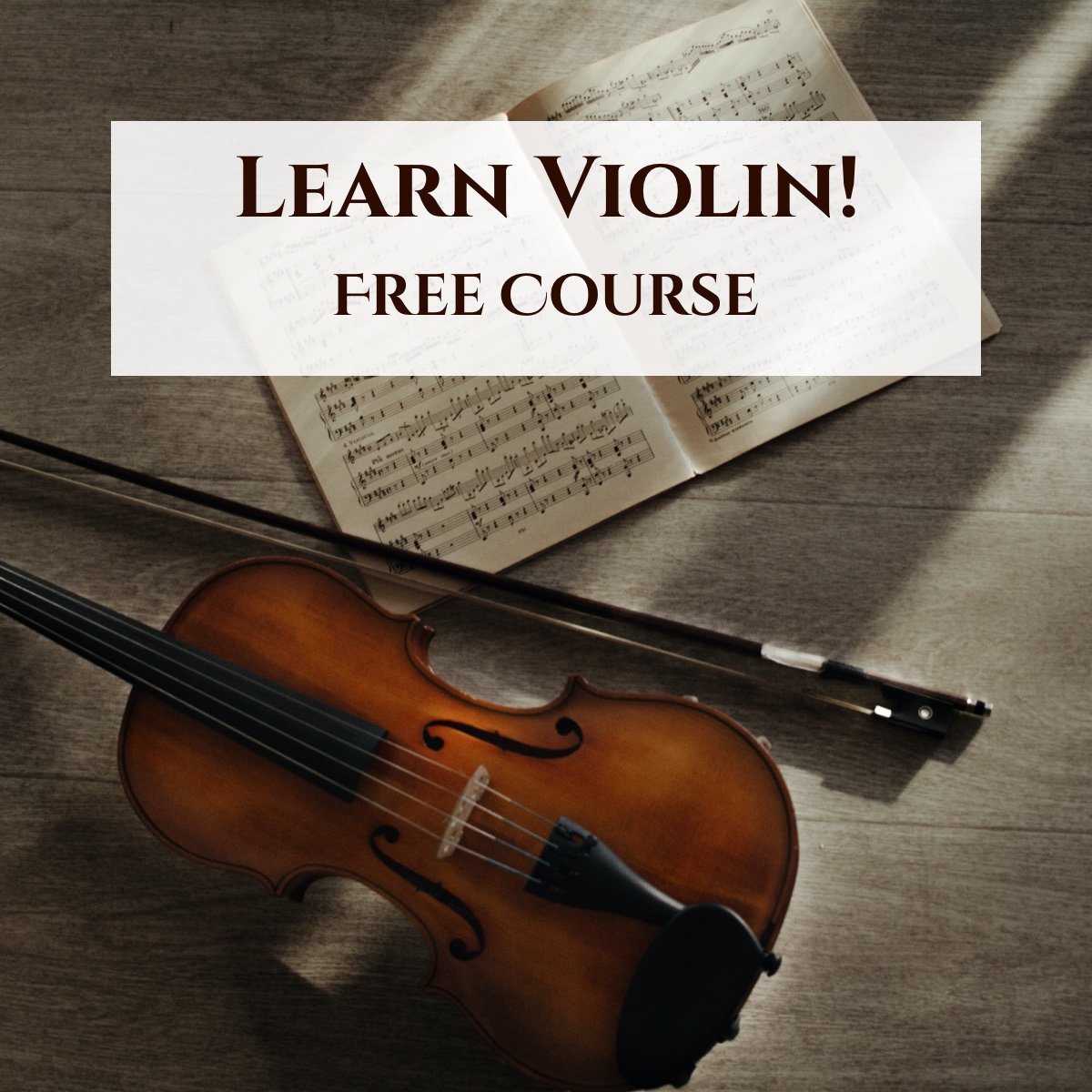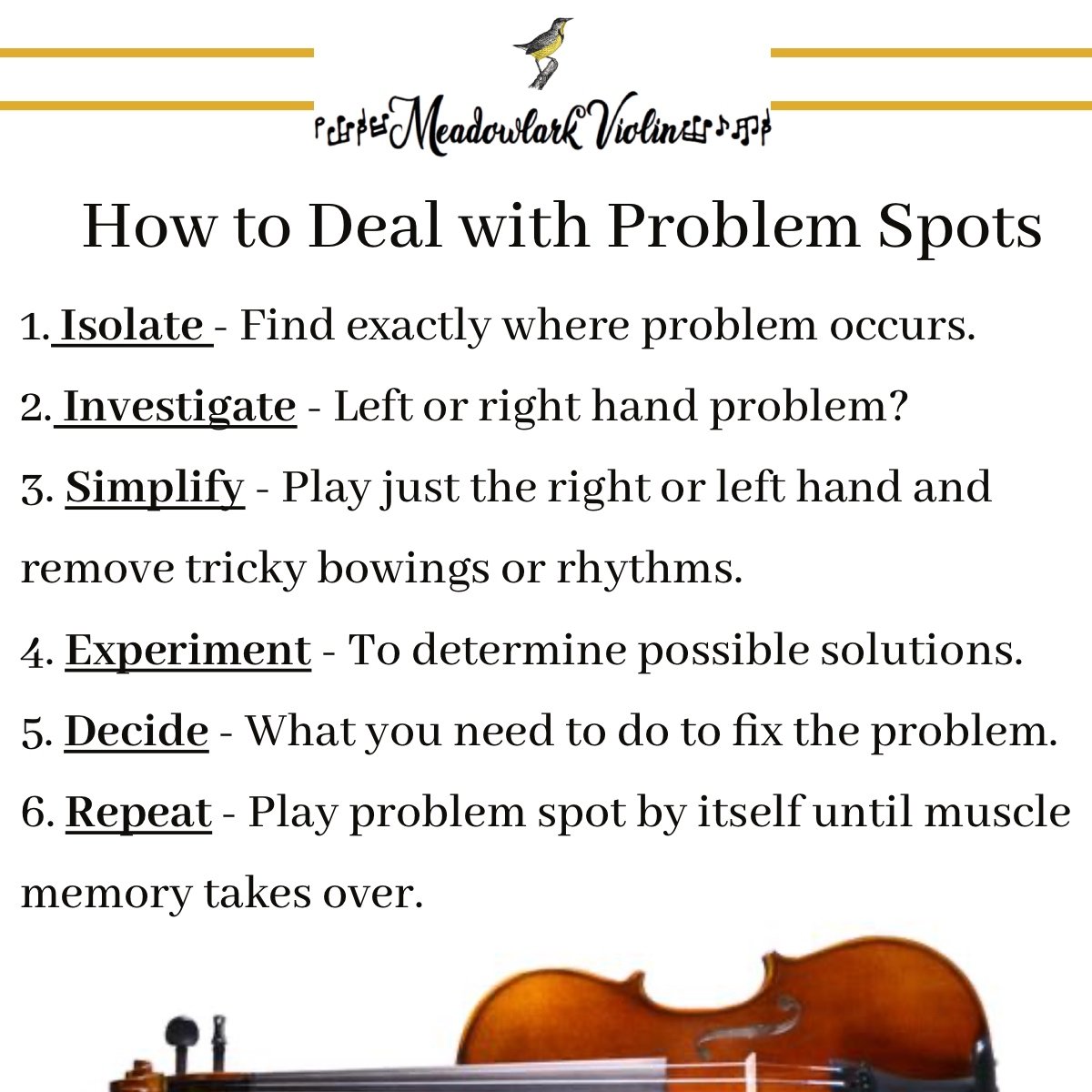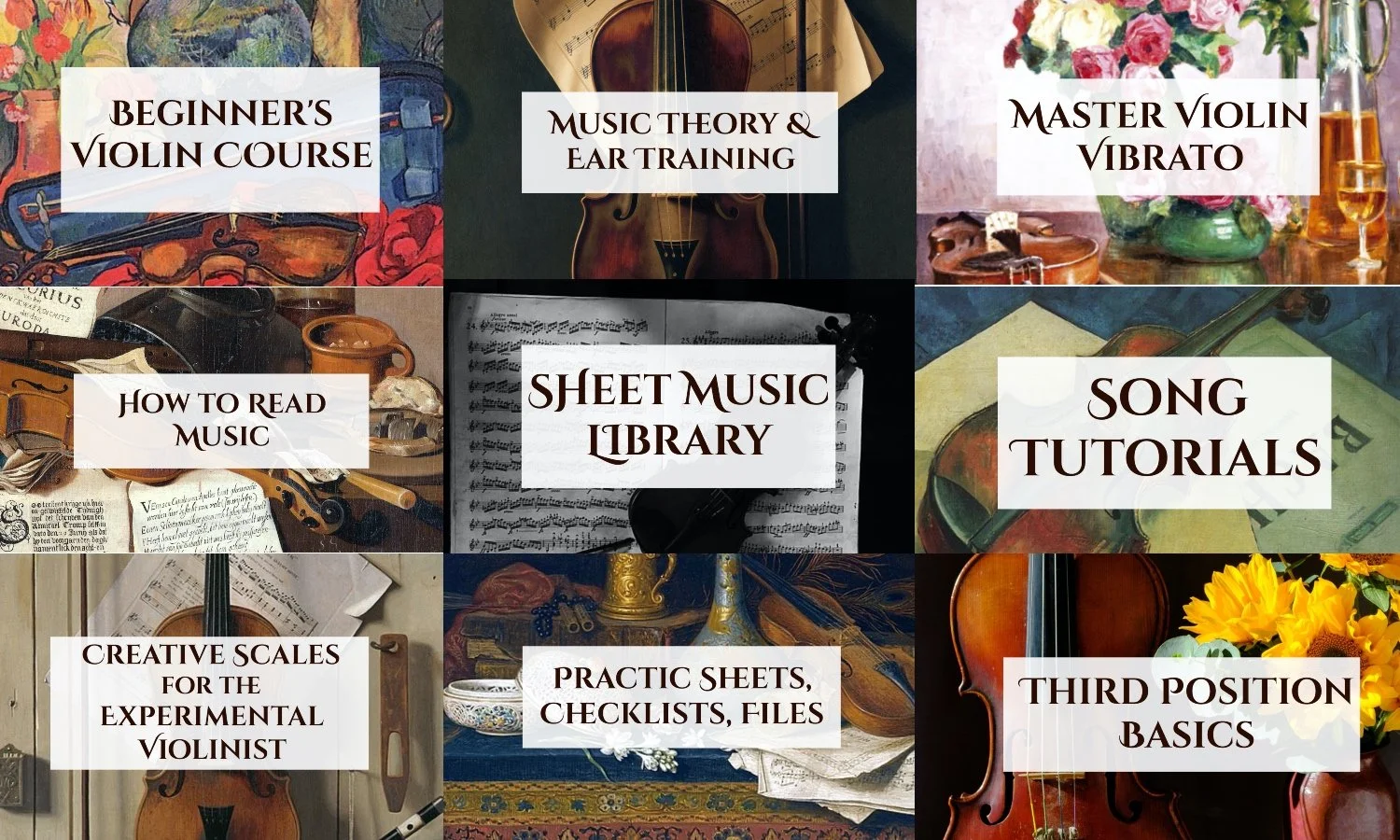Learn to Play Violin in 20 Steps
/If you are thinking you want to learn to play violin, get ready for a journey that will literally change your life. I dabbled in many instruments growing up: piano, harmonica, trumpet, guitar, but nothing grabbed me and wouldn't let go like the violin.
Learning to play the violin is not a just a hobby, it’s a way of life. You don’t have to have a degree in music to be a violinist, you just have to play violin!
My journey in learning to play the violin was not standard, but through it all I learned how to love this amazing instrument. While I had many teachers while I was learning, the majority of the time I spent alone in a practice room, teaching myself to play violin. Whether you have a teacher or not, if you want to learn to play violin, you have to learn to teach yourself how to play violin. The best learners are the ones who can teach themselves.
You may also be wondering if you’re too late to learn to play violin. I have a strong opinion about learning to play violin as an adult and I think I have authority (due to my circumstances) to answer this question. Check out my advice for adult beginners here and put this question to rest once and for all.
While learning the violin takes dedication and time, it’s incredibly rewarding. After teaching violin for over 15 years, I’ve developed 20 steps to help you learn to play violin by yourself and become the violinist you’ve always dreamed of being.
Download Your Free “Learn to Play Violin” Checklist
Click here to download your checklist.
Buy a Violin (Not a VSO)
Your first step in learning violin on your own is to purchase or rent a violin. This may seem like an easy first step but it can be deceptively overwhelming. Where do you buy a violin? How much should you spend on a violin? How do you know if it’s a good violin?
Unfortunately there are a lot of VSO’s (violin-shaped-objects) out there masquerading as real violins. I know because for years almost every new violin student would come to their first violin lesson with a VSO. VSO’s are cheaply made, sometimes impossible to tune, have inferior strings and inferior bows, and usually sound scratchy no matter how well you play.
I watched so many of my students get frustrated with the money and time they wasted on VSO’s that I wrote my very first blog post. Helping people find good quality instruments was the first mission of Meadowlark Violin and it still is a priority!
You may watch videos of professional violinists playing these $60 violins, but don’t be deceived. We’re working hard to make those violins sound decent. As a beginner learning violin yourself, you shouldn’t have to fight to get a good sound.
I wrote a detailed guide to help you find a real violin. Real violins aren’t that expensive. You can find a decent one with a bow and a case for as low as $250ish.
Read my recommendations for the 10 Best Violins for Beginners, plus get all the information you need about violin sizing, renting vs. buying, and more.
2. Buy a Shoulder Rest (And Any Other Equipment)
Repeat this step until you find a comfortable shoulder rest! A shoulder rest helps you keep the violin on your shoulder. (The back of the violin is curved and smooth, not ideal for staying right over your collar bone). Your violin probably comes with a bow and a case. It may even come with a shoulder rest.
Adjusting your shoulder rest correctly is one of the best things you can do for tension-free playing. Everyone has a unique body type, so finding a shoulder rest that is perfect for you may take some trial and error. Here are my top picks for shoulder rests that usually work with most body types.
If your violin outfit comes with a case, bow, and rosin (it should), you really don’t need any other equipment to get started.
I teach all of my students how to play violin without looking at sheet music (even if you know how to read music). That way you can focus entirely on the various different tasks that each hand is doing in addition to focusing on what your ear is telling you. If you are teaching yourself violin, don’t get caught up or distracted with what your eyes are telling you. So you won’t need a music stand to start off, but eventually when you start reading music, you’ll want a good, sturdy one so you don’t develop bad posture.
Eventually, you might want to upgrade to better rosin. The rosin that comes with your violin (if it’s a real violin and not a VSO) will probably be good enough for beginner violinists.
3. Start Listening to Music Voraciously
Do you notice I place this step before you even touch a violin? Listening to violin and fiddle music is literally the best, cheapest, and easiest step to learning violin yourself! Playing violin is all about developing ear training and there’s no better way to do that than to listen to music. If you are learning to play violin yourself, you’ve probably noticed there are dozens of styles of violin playing: classical, fiddle, Irish, gypsy….the list goes on. Listening to music will help you stay motivated as you learn to play violin.
Check out my playlist of Music I Can’t Live Without to get some ideas.
4. Sign Up for a Self-Taught Beginner’s Violin Course
It may be tempting to piece together a lot of Youtube videos to teach yourself violin, but this is a recipe for disaster and frustration. You’ll learn violin by random tidbits and never get a complete picture. If you’re learning violin by yourself, you’re likely to skip over important concepts that you will need later on. It’s frustrating to have to backtrack, so start out learning violin basics the right way.
My free beginner’s violin course has all the information you need to get started learning violin. From purchasing a violin, to tuning the violin, you’ll also learn the left hand notes, how to hold the bow, how to bow on the violin, plus and easy song. All of that in a little over an hour of instruction!
It’s totally free because it’s my mission to help as many people as possible learn to play violin! Sign up here.
5. Learn to Tune
Once you get your violin, the first task will be tuning the strings. Tuning is an art in itself. If you purchased a real violin and not a VSO, this step will be so much easier. In my free “Learn to Play Violin” course, I’ll show you the basics. You’ll also need a free tuning app.
6. Put on Your Shoulder Rest and Get it Adjusted
Learning to play violin yourself means constantly evaluating your playing and your body comfort level. Getting the shoulder rest adjusted comfortably is a big part of playing violin without tension. I’ll show you how you can easily put your shoulder rest on and adjust your shoulder rest in my free beginner’s course.
7. Separate the Left and Right Hands
Violin can be hard because the left and right hands are doing totally different things. If you are teaching yourself violin, one of the biggest mistakes you can make is trying to do everything at once. I always teach the left hand by itself (with pizzicato or plucking the strings) then I teach the bow hand by itself. As you get comfortable with each hand you can combine them. Learn to play violin in easy to master steps as opposed to trying to conquer everything at once. You’ll be less likely to get frustrated and make faster progress.
8. Focus on Ear Training Not Sight Training
If you are learning to play violin, you’ve probably noticed that there are no frets on a violin fingerboard! How do you know where to place your fingers? By ear! This may seem hard, but I can teach you how to place your first finger correctly without finger tapes in about a minute.
Finger decals may seem like an easy fix if you are teaching yourself violin, but they can actually harm your progress in the long run.
Finger tapes force you to rely on your eye sight. That means finger tapes cause you to use your eyes for a completely auditory skill! Why would you let your eyes tell your ears if you are in tune? It’s kind of like hiring a musician to do your taxes. It just doesn’t make sense.
One reason people who learn violin on their own get frustrated as they progress to the higher levels is because their ear is not up to par with the rest of their playing, because they never asked their ear to do anything! Then you have to start all over and teach your ear the basics.
With my method, I start teaching your ear to be in control from the very beginning. Don’t rely on visual cues for auditory skills. You’ll be happier with the results.
9. Practice Every Day (or Most Days)
If you want to learn violin yourself, it’s important to practice regularly. I do suggest taking one day off a week to refresh, but you should make it a goal to practice all the other days. It’s better to practice 30 minutes every day rather than two hours once a week.
10. Set Up a Practice Routine (And Stick With It)
If you are going to teach yourself violin, you have to be your own teacher, which means you need to hold your practice routine to a high standard! This is the ultimate key to success in my opinion. People who are learning to play violin get easily frustrated and feel like they never make progress if they don’t have a practice routine. That’s because they play a little of this and a little of that. When they hear a new song they want to learn they drop everything else and do that for a while until something else catches their ear. It’s impossible to make progress like that.
Getting a practice routine will help you make small steps of progression and it will be easy for you to see the progression, which will make you want to practice more!
I’ve got a great guide to practicing violin for beginners. Check it out here.
11. Avoid the Common Bad Habits
While everyone is different, every violin student usually deals with the same set of issues. Crooked left wrist, locked right thumb…I could go on.
In my Complete Violin Beginner’s course, I cover all of the bad habits I’ve seen from teaching violin for 15+ years. Learn the bad habits you need to avoid before they even become an issue!
11. Get Feedback
If you want to teach yourself violin, you can! With today’s technology it’s totally possible to learn violin completely on your own. However, it’s also important to get feedback. Sure, you can post videos on the internet and let the whole wide world offer you suggestions, or you can get feedback from a real, live, violin teacher. Even if you are learning violin on your own, getting your questions answered in a timely manner is important to making progress. With my Online Studio, you can post questions, videos, and pictures and get immediate feedback from me, a real-live-violin teacher. Easy peasy!
12. Go Slow
This is literally the best piece of advice I could give to someone wanting to learn violin. There is no timeline. Take it easy and go slow. You should go slow mentally but also physically. You should play slowly. How slow? Think if you were trying to annoy someone playing really, really, really, slowly. Yes, that slow. I still practice that slowly. I would be a better player now if my 15-year-old-self had practiced that slowly.
13. Know that the Bow is Everything
It’s easy to focus on the left hand, but as you teach yourself violin, you’ll soon realize that the bow is everything! It’s how you make things louder and softer, how you add phrasing and dynamics. It’s your tone, the very heart and soul of your playing. Most teach-yourself violin courses don’t focus nearly enough on the bow, but I start out from the beginning teaching you the fundamentals you need to be successful with the bow.
14. Find Community
Successfully learning violin yourself means you need to stay motivated. Learning violin can be frustrating so it’s very important to have a community of people like you to help you through the struggles. When you join the Meadowlark Violin Online Studio, you get an exclusive community filled with people just like you!
15. Learn to be a Detective
Teaching yourself violin is possible especially if you can learn to be a detective. What does that mean? Don’t just play a tricky measure a million times until it starts to sound good. Stop. Think through a problem. What exactly is making it hard? Is it a left or right hand issue? Separate the hands (remember step #7? It’s still important). Learn to find the very kernel of the thing that is causing the issue. Fix the issues instead of fixing the symptoms and you’ll be able to move on quickly to the next thing.
This is what I do when I teach myself violin and when I teach others! Be a detective!
16. Simplify
When learning music, always simplify it as much as possible, especially if you are dealing with a tricky measure. Take away the difficult bowing, simplify the rhythm. Get it down to its bare bones and then you’ll be able to see what the real issue is.
17. Start Playing with Others
Joining a jam session, a community orchestra, a church group, or just playing along with friends is essential to staying motived if you are learning to play violin yourself. It might seem intimidating but you’ll find people just like you, people who love the violin!
18. Learning Violin is a Cycle
Learning to play violin, even if you are doing all of these steps, does not mean you’ll progress without ever hitting any snags. This is the cycle of learning to play violin.
You’ll make progress and then all of the sudden it will seem like you can’t do anything right. Everything will sound horrible. This plateau is not a bad thing! In fact, it’s a good thing. It usually means that your ear is progressing. Little inadequacies with your intonation (how well you play in tune) or your tone will start to bother you. That’s great! It doesn’t mean that all of the sudden you are having those issues. You probably always played like that, but now you are hearing and picking up on more things than you did before. Give your ear a pat on its proverbially back. It’s doing its job.
When you realize learning violin is a cycle, you’ll reach those plateaus, understand what’s going on, learn to fix the issues, and then continue to make progress.
19. Have a Clear Path for Progression
Okay, so you’ve taught yourself the basics of the violin. What next? If you are learning violin on your own, you are in charge of your next steps, and that can be overwhelming. You might find you are just swimming around in a whirlpool doing the same things and never getting better and learning “the next thing.”
Having a clear path for progression is vital if you want to teach yourself violin. My online membership makes that path clear for you so you don’t have to continuously think, “What do I do next?”
I’ve created Progress Pathways for Meadowlark Violin Studio so that you can get everything you need, all in one place.
In addition there’s live events, community forum, and so much more. Learn more here!
20. Don’t Give Up
My last piece of advice may seem obvious, but if you want to play violin, you have to play violin. Violin can be hard, but anything worth having in this world usually takes some effort. The more effort it takes, the more it’s worth it. When you learn to play violin and start telling others that you play, you’ll usually hear one of two responses. Either, “I’ve always wanted to play violin.” Or “I used to play violin…” Don’t be either of those two people. If this is what you want to do, you can do it. You can teach yourself violin and play the music you love. You just have to pick up the violin and start playing.
Comment below and let me know what you think. Are you ready to learn violin?!
Happy Practicing!
~Lora

























